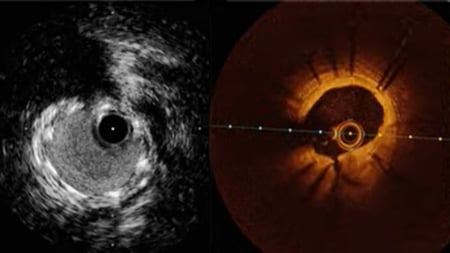31 Jan 2020
Effect of intravascular ultrasound-guided drug-eluting stent implantation: 5-year follow-up of the IVUS-XPL randomized trial
Selected in JACC: Cardiovascular Interventions by B. Ezhumalai , S. Brugaletta
In IVUS-XPL (Impact of Intravascular Ultrasound Guidance on the Outcomes of Xience Prime Stents in Long Lesions) trial the long-term outcomes of stent optimisation with IVUS were analysed.
References
Authors
Hong SJ, Mintz GS, Ahn CM, Kim JS, Kim BK, Ko YG, Kang TS, Kang WC, Kim YH, Hur SH, Hong BK, Choi D, Kwon H, Jang Y, Hong MK; IVUS-XPL Investigators.
Reference
JACC Cardiovasc Interv. 2020 Jan 13;13(1):62-71
Published
January 2020
Link
Read the abstractReviewers
Our Comment
This joint review is part of the PCRonline GLOBAL Journal Club Initiative by selected members of the EAPCI/PCR Journal Club and EAPCI young ambassadors, and is based on the underlying idea of “Bringing peers together, exchanging ideas, towards a common standard of care”.
Why this study – the rationale/objective?
Intravascular ultrasound (IVUS) guided PCI produces favourable 1-year clinical outcome but there is hardly any randomized trial which evaluated the long-term effect of IVUS guidance during DES implantation. In IVUS-XPL (Impact of Intravascular Ultrasound Guidance on the Outcomes of Xience Prime Stents in Long Lesions) trial the long-term outcomes of stent optimisation with IVUS were analysed.
How was it executed – the methodology?
The IVUS-XPL trial was an investigator-initiated, multicenter study that included 1,400 patients with long coronary lesions (implanted stent length ≥28 mm), randomised to receive IVUS-guided (n = 700) or angiography-guided (n = 700) everolimus-eluting stent implantation (Xience Prime, Abbott Vascular, Santa Clara, California). Patients in IVUS-XPL were followed up to 5 years. The primary outcome was the composite of major adverse cardiac events, including cardiac death, target lesion–related myocardial infarction, or ischemia-driven target lesion revascularization at 5 years.
What is the main result?
- 1,315 patients (94%) completed 1-year follow-up and 1,183 patients (85%) completed 5-year follow-up in this study.
- Major adverse cardiac events at 5 years occurred in 36 patients (5.6%) receiving IVUS guidance and in 70 patients (10.7%) receiving angiographic guidance (p = 0.001).
- This difference was driven mainly by a lower risk for target lesion revascularization (31 [4.8%] vs. 55 [8.4%]; p = 0.007).
- Major adverse cardiac events between 1 and 5 years occurred in 17 patients (2.8%) receiving IVUS guidance and in 31 patients (5.2%) receiving angiographic guidance (p = 0.031).
Critical reading and relevance for clinical practice
Several previous studies have shown that IVUS-guided DES implantation was superior to angiography-guided DES implantation but all these studies reported outcomes within 2 years. IVUS-XPL trial demonstrated that IVUS guided PCI was associated with a substantial reduction in the risk for major adverse cardiac events at 5 years compared with angiographic guided PCI; 1-year beneficial effect of IVUS guidance was not only sustained up to 5 years but increased between 1 and 5 years.
In the angiography-guided stent implantation group, stent size and length were chosen based on visual estimation and post dilatation was performed only if the optimal result was not achieved. In the IVUS-guided stent implantation group, IVUS was used at any step of PCI (before, during, or after PCI): stent size and length were selected by IVUS measurements, and high-pressure dilation was performed on the basis of the IVUS findings. IVUS criteria for stent optimization after PCI were defined as a minimal luminal cross-sectional area greater than the luminal cross-sectional area at the distal reference segments.
This study had the following limitations: only long lesions were included and only single type of DES was used for PCI; drop-out rate was high (15%) and the observed event rate was relatively low in this study. Further randomised studies involving more complex lesions are required to evaluate the real-world long-term outcomes of IVUS guided PCI.
IVUS guidance is of utmost utility in PCI of left main coronary artery. IVUS-guided optimisation of stent may reduce events like stent thrombosis by avoiding stent under-expansion and strut malapposition. This may enable to shorten the duration of dual-antiplatelet therapy.







1 comment
I like Discussion